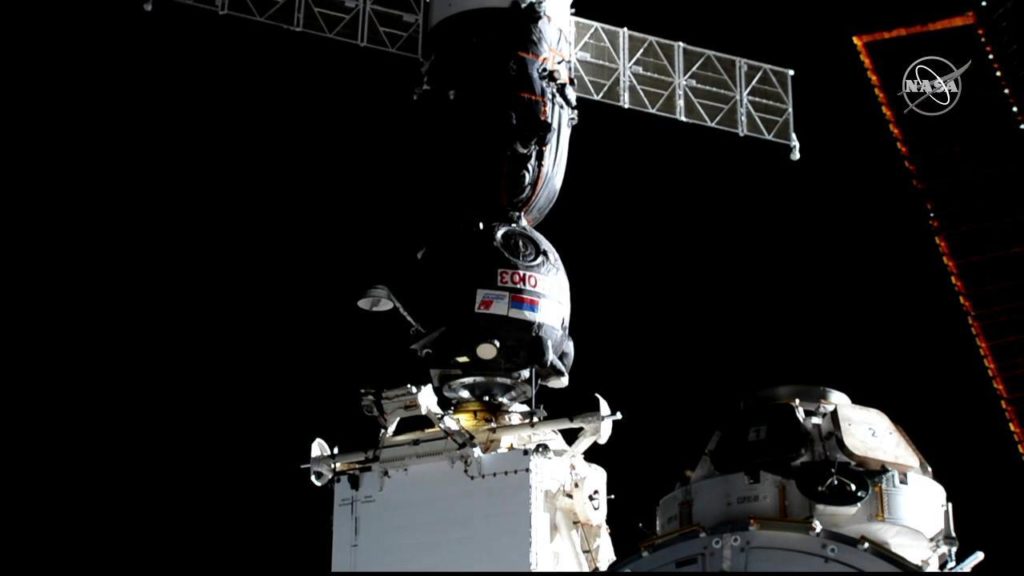There was much international news in mid-March, although little of it was encouraging for those who prefer peace to war, handshakes to sabre-rattling, and cooperation to confrontation.
But there was one item of good cheer which showed that friendly cooperation between the US and Russia continues, albeit unobtrusively. It concerned the International Space Station, about which it was reported on March 15 that “A Russian Soyuz rocket carrying NASA astronauts Nick Hague and Christina Koch along with Roscosmos’ Alexei Ovchinin lifted off as planned from the Baikonur cosmodrome in Kazakhstan… Their Soyuz MS-12 spacecraft reached a designated orbit about nine minutes after the launch, and the crew reported they were feeling fine and all systems on board were operating normally.”

Russia’s Soyuz spacecraft docked with the International
Space Station about 250 miles over the Pacific Ocean.
The mission was successful, technically and professionally, but did not in any way diminish Washington’s anti-Russian bias or its determination to militarize space.
A forecast for the second quarter of 2019 by the analytical think-tank STRATFOR reflects the Washington Establishment’s line that “Military competition between the United States and Russia will prevail…” but does not record that the military budget of the United States is vastly more than that of Russia, or that, as headlined in the 2018 Report by the Stockholm International Peace Research Institute, world defence expenditure “falls sharply in Russia, but rises in Central and Western Europe.” As is well-known, the US will spend 716 billion dollars on its military in 2019, but what is not publicised by the Western media is that Russia’s 2019 outlay is 45 billion dollars.
The word ‘competition’ (“the activity or condition of striving to gain or win something by defeating or establishing superiority over others”) is hardly appropriate when the figures involved are 716 compared to 45 whether these be dollars or coconuts, but the competition myth continues, supported energetically by Washington’s military-industrial complex — and especially by the generals, spurred on by the lure of lucrative post-retirement jobs with manufacturers of military systems. Stars and Stripes records that “major US defense contractors have hired hundreds of former high-level government officials in recent years, including at least 50 since Trump became president. The report lends new visibility to long-standing concerns about a revolving door between the government agencies that award massive contracts for military supplies and services and the businesses that profit from those contracts.”
Which leads us to General “Fighting Joe” Dunford, who at his Senate hearing for appointment as Chairman of the Joint Chiefs of Staff said “my assessment today, Senator, is that Russia presents the greatest threat to our national security.” In October 2018 he reiterated that “the Russian challenge is not isolated to the plains of Europe. It is a global one” requiring the armed forces of the United States “to be able to project power to an area… and then once we’re there we’ve got to be able to freely manoeuvre across all domains… sea, air, land, space, and cyberspace.”
Naturally he didn’t mention that at the very time he uttered his confrontational challenges there was close cooperation in air, land and space between the US and Russia whose astronauts were “able to freely manoeuvre” in harmony, adding to world knowledge and engendering trust by jointly conducting research projects in the International Space Station.
This is in accord with the United Nations ‘Treaty on Principles Governing the Activities of States in the Exploration and Use of Outer Space’, otherwise known as the Outer Space Treaty of 1967, which, among other things “establishes basic principles related to the peaceful use of outer space. This includes that the exploration and use of outer space shall be carried out for the benefit and in the interests of all countries…”
It is the wish of the world — or most of the world — that space should be forever free of weapons. The Treaty lays down that “States Parties to the Treaty undertake not to place in orbit around the earth any objects carrying nuclear weapons or any other kinds of weapons of mass destruction, install such weapons on celestial bodies, or station such weapons in outer space in any other manner.”
But although the United States signed and ratified the Space Treaty in 1967, it strongly objected to later attempts to refine it. In February 2008 the New York Times reported that “The Russian foreign minister, Sergey V Lavrov, presented a Russian-Chinese draft treaty banning weapons in space to the United Nations Conference on Disarmament, an idea that was quickly rejected by the United States.”
It is a difficult to imagine why there could be any objection to a treaty aimed at “prevention of the placement of weapons in outer space,” but the White House responded that it opposes any treaty that seeks “to prohibit or limit access to or use of space.” Indeed the White House said that such a treaty would be impossible to enforce because “any object orbiting or transiting through space can be a weapon if that object is intentionally placed onto a collision course with another space object. This makes treaty verification impossible.” The US continues to be resistant to any treaty forbidding deployment of weapons in space.
It was therefore unsurprising when Trump put forward his plan for militarising space in March last year, and in August tweeted “Space Force All the Way!” Then he declared on February 19 that “we’re investing in new space capabilities to project military power and safeguard our nation’s interests, especially when it comes to safety and defense” and signed a directive ordering the Pentagon to create a Space Force as the sixth branch of the military.
The result of his brainwave is that the US is going to “project military power” in space, which is directly contrary to “the basic principles related to the peaceful use of outer space” noted in the Outer Space Treaty.
The US refuses to move onwards from the original treaty, and on March 20 Newsweek summed up Washington’s policy by noting that “the United States has blamed Russia and China for militarizing space, while refusing to sign their joint proposal against placing weapons there.”
On February 19, while preparations were in full swing for launch of the joint Russia-US mission to the International Space Station three weeks later, the White House announced that “President Donald J Trump’s Space Policy Directive-4 is a bold, strategic step toward guaranteeing American space dominance” by “establishing the United States Space Force which among other tasks will “organize, train and equip our space warfighters with next-generation capabilities.”
In the words of the US Administration, “space is now a warfighting domain just like the air, land and sea” so it’s goodbye to a future of harmonious exploration and scientific research in the regions beyond our globe. It had been hoped that the Treaty would go far to assist in “maintaining international peace and security and promoting international co-operation and understanding” but Washington has no intention of agreeing to any international law that would prohibit extra-terrestrial weaponisation, and Trump’s Space Directive has now set the seal on Washington’s preparedness to confront in space as well as by land and sea and in the air. Stand by for Space War.









